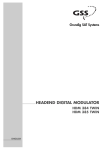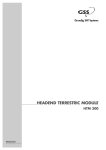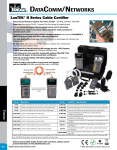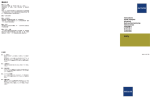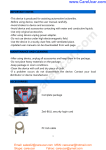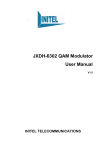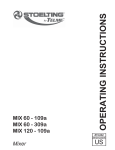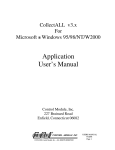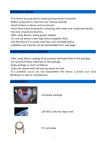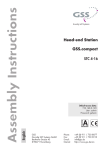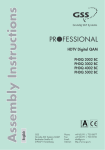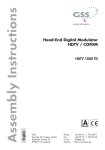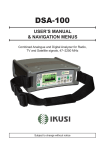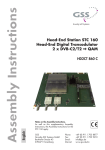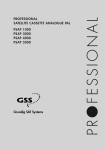Download PROFESSIONAL SATELLITE DIGITAL QAM PSDQ 4000 PSDQ
Transcript
PS DQ 4000 PS DQ 5000 FESSIONAL PROFESSIONAL SATELLITE DIGITAL QAM PR Grundig SAT Systems CONTENTS 3 ________________________________________________________________________ General Scope of delivery Technical data The DVB twin transmodulator boxes QPSK- QAM PSDQ 4000 and PSDQ 5000 5 Installation Installing the transmodulator box into the Headend station and connecting it. 6 The Menu Guide The menu guide at a glance 8 Setup Setting up the transmodulator box Adjusting the output levels of the channel lines A and B to each other LNB frequency Output channel Frequency offset Service settings – Example Symbol rate Input frequency (transponder frequency) QAM modulation value Saving all settings Explanation of the »Symbol rate« term Service (at the end of this user manual) Channel/frequency tables 2 GENERAL ____________________________________________________________________________ Scope of delivery 1 DVB twin transmodulator box PSDQ 4000 or PSDQ 5000 2 RF connecting cables 1 user manual 1 technical evaluation 1 supplement leaflet (Premiere World) Technical data This product conforms with the requirements of the 73/23/EC and 89/336/EC guidelines of the European Council. The standards EN 50083-2, EN 50083-2/A1, EN 50083-1, and EN 60065 required for the CE certification are kept to. RF output: PSDQ 4000 Channels: Frequency range: Channel norm: PSDQ 5000 Channels: Frequency range: Channel norm: Output level: Output impedance: Frequency detuning of the output signal: Connectors: SAT input: RF output (modulator): 10-pin connector: RS 232 socket (9-pin): 950–2150 MHz 1 MHz 35 dBµV....80 dBµV 36 MHz 1....30 Msymb./sec., MCPC/SCPC S21....S41 306.00 MHz....466.00 MHz (centre channel frequencies) PAL CCIR Standard B/G C21....C69 474.00 MHz....858.00 MHz (centre channel frequencies) PAL CCIR Standard G typ. 90 dBµV 75 Ohm, nominal ±4.00 MHz in 125-kHz steps 2 F-sockets, (screw terminals) 1 IEC socket, female for all supply voltages and the I 2 C bus deactivated - without function Important ! If the GRUNDIG trasporting current module (optional asscessory) is fitted into this satellite box, the RS 232 socket (serial interface) at the font side of the satellite box is activated. Using a PC or notebook, it is possible to upate the software of the satellite box via this socket. Subject to technical modifications and errors. ENGLISH RF input: Frequency range: Frequency spacing: Level range: IF bandwidth: Symbol rate: 3 GENERAL___________________________________________________________________________________ The DVB twin transmodulator boxes QPSK-QAM PSDQ 4000 and PSDQ 5000 These twin transmodulator boxes are QPSK-QAM modulators which convert QPSK 1) modulated signals from a satellite into a QAM 2) modulated cable signal for being distributed via a cable system. These modulation procedures are layed down by international standards for the transmission medium (QPSK ➞ satellite signal path, QAM ➞ cable) and use in an optimum way the available bandwidth. 1) QPSK = Quadrature Phase Shift Keying 2) QAM = Quadrature Amplitude Modulation (QPSK = 4 QAM) The boxes are controlled via the GRUNDIG Professional Headend station’s PSU 8 and PSU 12. Each twin box has two SAT inputs and 1 RF output. Each box has two channel lines (channel lines A and B). One channel line consists of a digital SAT tuner, the digital signal processors, and an analog converter. The two channel lines of a transmodulator box are indicated as Box A and Box B in the display of the control unit. The two input signals are processed according to the box specifications, and then passed via the RF output socket to the RF output collector of the basic module carrier. The common output level (channel lines A and B) of the box can be adjusted using the mechanic level control (max. – 20 dB) on the RF output collector of the Headend station. After switching the headend station on, the software version of the control unit is briefly shown in the 2-line LC display. About 5 minutes after the last key is pressed, the display is automatically switched off, or the software version of the control unit is displayed. Note: If desired, the software version of the control unit can also manually be called up and displayed as follows: Press and hold down any two buttons on the control unit at the same time until the following occurs: – The display turns dark. After several seconds, the software version, e.g. V.19, appears. 4 INSTALLATION SAT INPUT B ______________________________________________________________ SAT INPUT A RS 232 Installing the transmodulator box into the basic module carrier and connecting it Caution: Before fitting or replacing a cassette, it is absolutely necessary to disconnect the mains plug from the headend station. 1 Undo the fixing screws of the mounting frame, then fit the cassette into a free slot and refit the fixing screws. 2 Plug the HF input cables into the HF input sockets SAT INPUT A (channel line A) and SAT INPUT B (channel line B) (see Figure). 3 Reconnect the headend station to the mains supply. – The cassette is now connected with all necessary supply voltages and data lines and ready for use. ENGLISH Important ! If the GRUNDIG trasporting current module (optional asscessory) is fitted into this satellite box, the RS 232 socket (serial interface) at the font side of the satellite box is activated. Using a PC or notebook, it is possible to upate the software of the satellite box via this socket. 5 THE MENU GUIDE ____________________________________________________ Note: You may select the individual menus or menu items by pressing the MODE key. To go back to the access menu without saving the settings made, press the MODE key longer than 2 seconds. When in a menu, use the ľ and ı keys to select the desired setting, and then the + and – keys to change the settings. Press the M key to save all settings and to return to the access menu. The following examples show the setup of the transmodulator box PSDQ 4000; on this box, the output channels S21 to S41 can be selected. ON BE–Remote V . 19 please wait . . . V.19 Software version of the Headend station’s control unit ca. 10 Sec. MULTI +/ – select box number and channel line A/B +/ – Bx 1A TWIN–QAM S21– S41 S21 Bx 1A TWIN–QAM LEVEL HF OUT: O cut output level of TWIN-QAM boxes (channel line A or B) (0 to –7 dB) MULTI MODE +/ – enter LNB frequency Bx 1A LNB-Freq. : f = 10600 MHz MODE MULTI +/ – select output channel (channel centre) Ł ≥ 2 sec. fine (offset) ĵ back Bx 1A OUTPUT: AUSGANGSKANÄLE A/B S21 (306,00) OUTPUT CHANNELS A/B MULTI MODE MULTI MULTI select Bx 1A OUTPUT: LEVEL CONTROL Bx 1A MULTI OUTPUT: Modulator on Bx 1A OUTPUT: RANDOM 6875 kBd +/ – Modulator off/on MULTI MULTI Bx 1A SPECTRUM OUTPUT: normal +/ – Spectrum normal/ inverse MODE Continued on next page. 6 THE MENU GUIDE______________________________________ continued select SR Ł FEC ĵ Ł ĵ +/ – INPUT: Bx 1A SR=27500 FEC=aut change setting MODE +/ – enter input frequency Bx 1A INPUT: f=12050 0 MODE +/ – adjust QAM value Bx 1A QAM–MODE: SR=6875 64-QAM MODE back to access menu MODE ≥ 2 sec. Bx 1A S21- S41 TWIN–QAM S21 reset all settings M M ENGLISH save all settings 7 SETUP _____________________________________________________________________________________ Setting up the transmodulator box The transmodulator box is set up exclusivley via the keyboard of the basic module carrier’s control unit. The user is guided by means of the two-line display on the control unit. BE–Remote V . 19 PROFESSIONAL 1 You may select the following menu items with the MODE key. – – – – – – – Box number and channel line (adjust output level of channel line A or B) LNB frequency Output channel, frequency offset Service settings Symbol rate, FEC Input frequency (transponder frequency) QAM modulation value Note: The following examples show the setup of the transmodulator box PSDQ 4000; on this box, the output channels S21 to S41 can be selected. Selecting the box number and the channel line (A or B) Bx 1A TWIN-QAM S21–S41 S21 1 The access menu, e.g. » Bx 1A 2 Use the + or (A or B). – TWIN-QAM « appears in the display. key to select the desired box number and the channel line Adjusting the output levels of the channel lines A and B to each other Note: The following adjustment is only necessary if the output level of the two channel lines A and B of one box differs by ≥ 1dB. Bx 1A TWIN-QAM LEVEL HF OUT: 0 1 Press the MULTI key. The »Bx 1A or Bx 1B example, appears in the display. LEVEL HF OUT:« menu, for Note: Check the output level of the channel lines A and B. 2 Using the – key, adjust the higher output level of the respective channel line A or B to the lower output level of the other channel line in steps from » 0 to – 7« dB. Selecting the LNB frequency Bx 1A f = 10600MHz 8 LNB-Freq.: 1 Press the MODE key. The »LNB-Freq.:« menu appears in the display. 2 Use the + or – key to select the correct LNB frequency. SETUP ________________________________________________________________________________________ Selecting the output channel Bx 1A OUTPUT: S21 (306,00) Bx 1A OUTPUT: S21 (306,00) 1 Press the MODE key. The »OUTPUT:« menu appears in the display. 2 Call up the preset output channels of the box by pressing the MULTI key repeatedly. Note: The channels between »S21« and »S41« can be selected. Please note that the associated frequency shows the channel centre. The centre channel frequency lies 2.75 MHz above the usual picture carrier frequency. A frequency/channel table can be found at the end of this user manaul. 3 Use the + or – key to select the desired output channel. Adjusting the frequency offset Attention: The frequency fine tuning (offset) should only be changed in exceptional cases, as it requires all TV sets which are connected to the cable system to match this setting by effecting a corresponding fine tuning correction. Bx 1A S21 OUTPUT: Fine 0 1 Press the ı key until “Fine 0” appears also in the display. Then use the + or – key to select a different “Fine” setting. Press the ľ key to return to the output channel. The service menu Bx 1A OUTPUT: 1 Press the MODE key. The »»OUTPUT: LEVEL CONTROL«« menu appears in the display. LEVEL CONTROL Note: A power-equivalent RF carrier is generated on the picture carrier of the respective channel. With that, it is possible to adjust the level of the box with any commercial measuring receiver tuned to the picture carrier frequency of the respective channel. To prevent interferences inside the Headend station and the cable system, the output level of digital boxes must be cut by about 8 dB with respect to analog TV channels. The following example gives detailled information on what is to be observed and how to proceed. Example: 2 Connect a commercial analog TV measuring receiver to the RF output socket »AUSGANG« of the Headend station. 4 Adjust the TV measuring receiver to the selected output channel (e.g. S 21) of the digital box. Continued on next page. ENGLISH 3 Measure the output level of an analog box, and then adjust it to a common output level (e.g. 100 dBµV). 9 SETUP ________________________________________________________________________________________ 5 Check the output level of the digital digital Twin QAM box. Using the level control situated to the right of the box, you can reduce the output level of the box by about 8 dB (= 92 dBµV). Note: Cutting of the output level effects both channel lines A and B of the digital Twin QAM box. Bx 1A OUTPUT: 6 Press the MULTI key. The » OUTPUT: control unit’s display. M odulator« menu appears in the Modulator on 7 Use the + or or on again. Bx 1A RANDOM Bx 1A Spectrum OUTPUT: 6875 kBd OUTPUT: – key to switch the respective modulator (Output channel) off 8 Press the MULTI key. The » OUTPUT: RANDOM « menu for service functions appears in the control unit’s display. – In the second menu row, the associated output symbol rate, e.g. »6875 kBd « (= 6875 Kilosymbols/sec.), is indicated. 9 Press the MULTI key once again. The »OUTPUT: appears in the display. Spectrum « submenu normal Note: The spectrum of the useful signal can be inversed. An inversion is only necessary in exceptional cases and for certain older digital cable receivers. 10 Using the + or – key, select the »inverse« or »normal« spectrum setting. Adjusting the symbol rate »SR« Bx 1A SR=27500 INPUT: FEC=aut 1 Press the MODE key. The »INPUT:« menu appears in the display. Note: The symbol rates »SR« of satellite transponders can be found in current tranponder tables or in various satellite magazines. 2 Use the value. ľ key to select »SR«. Then use the + or – key to set the appropriate FEC – Forward Error Correction = standardized error protection system for digital TV broadcasts. FEC = aut, automatic FEC. Note: FEC values can be found in the actual channel tables of the satellite operators. If no reception is possible even after entering all parameters, it is also possible to enter the FEC value manually. Bx 1A SR=27500 10 INPUT: FEC=aut 3 Use the ı k e y t o s e l e c t »FEC«, and then repeatedly press the + or – key until the picture/sound signal of the desired satellite channel appears on the picture screen. – In the second menu row appear one after the other: – FEC = aut, FEC = 1/2, FEC = 2/3, FEC = 3/4, FEC = 5/6, FEC = 7/8 and then FEC = aut‚ again. SETUP ________________________________________________________________________________________ Selecting the input frequency (transponder frequency) Bx 1A f=12050 Bx 1A f=12050 Bx 1A f=12050 Bx 1A f=12050 INPUT: 0 INPUT: ... INPUT: 1 Press the MODE key. The »INPUT:« menu appears in the display. 2 Use the + or – key to set the input frequency. Note: If three dots » « appear in the second menu row, the box is in channel search mode – please wait. When the RF reception unit has synchronized with the input signal, a possible frequency offset with regard to the desired frequency in MHz, e.g. » – 1.8«, is indicated. ... 3 Using the + or – key, correct the input frequency until the frequency offset becomes less than 1 MHz. 0 INPUT: ? Note: If a question mark » ? « appears in the second menu row, no input signal has been found. In this case, check the overall configuration of the satellite system and of the Headend station, as well as the previous settings of the transmodulator box concerned. Adjusting the QAM modulation value Bx 1A 64 – QAM QAM–MODE SR=6875 1 Press the MODE key. The »QAM-MODE« menu appears in the display. – In the second menu row the associated output symbol rate, e.g. »6875« Kilosymbols/sec., is indcated. Attention: For the manual channel search on a connected digital cable receiver, this must also be set to this value (e.g. »6875« Kilosymbols/sec.). 64 – QAM Bx 1A 64 – QAM QAM–MODE SR=? QAM–MODE Error Attention: The following restrictions must be observed: The box can only generate a maximum symbol rate of 7000 Kilosymbols/sec. A very high input symbol rate can cause an output symbol rate of > 7000 Kilosymbols/sec. – In this case, »Error« appears in the second menu row. The box then must be adjusted to a higher QAM mode value (128 or 256) in order to adjust the output symbol rate to the admissible value of < 7000 Kilosymbols/sec. An output symbol rate of above 64-QAM results in very high demands on the cable network. Due to noise, runtime and frequency response problems, reception of the converted output signal may become impossible. However, it may be expected that all satellite transponders will operate in the future with symbol rates allowing an output symbol rate of 64-QAM. Continued on next page. ENGLISH Bx 1A Note: Normally 64-QAM are transmitted on the cable system. If a question mark » ? « appears in the second menu row, the transmodulator box is unable to generate an output signal. In this case, check the overall configuration of the satellite system and of the Headend station, as well as the previous settings of the transmodulator box concerned. 11 SETUP ________________________________________________________________________________________ Attention: Too low input symbol rates may also cause problems. Certain digital satellite receivers (set-top boxes) allow only for a minimum specific symbol, or the digital box limits this range to 1000 Kilosymbols/sec.. If you note when setting 64-QAM that the resulting symbol rate is too low for certain set-top boxes or the transmodulator box, you must set a lower QAM (ideal is 16-QAM). The resulting symbol rate then lies in the admissible range again. Bx 1A S21–S41 TWIN-QAM S21 Saving all settings 1 Press the M key to save all new settings. – The access menu, e.g. »»Bx 1A TWIN-QAM«, reappears in the display. Explanation of the »Symbol rate« term High-value modulation modes such as QPSK or QAM allow for the encryption of several bits by means of a single physically transmittable and receivable symbol. The useful data flow contains the picture/sound signal of one satellite transponder and is therefore fixed. If the modulation degree and thus the number of bits per second is increased, the symbol rate decreases for a given useful bit rate. Below you find formulas for the calculation of the output symbol rate »SR (A)« for a given input signal rate» SR (E)« and »FEC «. Note: If no FEC is given in the programme tables, an FEC = 3/4 can be assumed. 256-QAM: 128-QAM: 64-QAM: 032-QAM: 016-QAM: 004-QAM: SR SR SR SR SR SR (A) = FEC x 1/4 x SR (E) (A) = FEC x 2/7 x SR (E) ( A ) = FEC x 1/3 x SR ( E ) (A) = FEC x 2/5 x SR (E) (A) = FEC x 1/2 x SR (E) (A) = FEC x 1/1 x SR (E) Example: Output symbol rate 64-QAM Input symbol rate SR (E) at 27500 Kilosymbols/sec., FEC = 3/4 SR (A) = FEC 3/4 x 1/3 x SR (E) 27500 Kilosymbols/sec. = 6875 Kilosymbols/sec.. 12 SERVICE ________________________________________________________________________________ Kanal-/Frequenztabelle, Hyperband Channel/Frequency Table, Hyperband Kanal Channel Frequenz Kanalmitte in MHz Channel centre frequency in MHz (Frequenz Bildträger in MHz) (Picture carrier frequency in MHz) S 21 306,00 (303,25) S 22 314,00 (311,25) S 23 322,00 (319,25) S 24 330,00 (327,25) S 25 338,00 (335,25) S 26 346,00 (343,25) S 27 354,00 (351,25) S 28 362,00 (359,25) S 29 370,00 (367,25) S 30 378,00 (375,25) S 31 386,00 (383,25) S 32 394,00 (391,25) S 33 402,00 (399,25) S 34 410,00 (407,25) S 35 418,00 (415,25) S 36 426,00 (423,25) S 37 434,00 (431,25) S 38 442,00 (439,25) S 39 450,00 (447,25) S 40 458,00 (455,25) S 41 466,00 (463,25) Continued on next page. SERVICE _____________________________________________________________________________________ Kanal-/Frequenztabelle, Band IV/ V, CCIR Channel/Frequency Table, Band IV/ V, CCIR Kanal Channel Frequenz Kanalmitte in MHz Channel centre frequency in MHz (Frequenz Bildträger in MHz) (Picture carrier frequency in MHz) C 21 474,00 (471,25) C 22 482,00 (479,25) C 23 490,00 (487,25) C 24 498,00 (495,25) C 25 506,00 (503,25) C 26 514,00 (511,25) C 27 522,00 (519,25) C 28 530,00 (527,25) C 29 538,00 (535,25) C 30 546,00 (543,25) C 31 554,00 (551,25) C 32 562,00 (559,25) C 33 570,00 (567,25) C 34 578,00 (575,25) C 35 586,00 (583,25) C 36 594,00 (591,25) C 37 602,00 (599,25) C 38 610,00 (607,25) C 39 618,00 (615,25) C 40 626,00 (623,25) C 41 634,00 (631,25) C 42 642,00 (639,25) C 43 650,00 (647,25) C 44 658,00 (655,25) C 45 666,00 (663,25) C 46 674,00 (671,25) C 47 682,00 (679,25) C 48 690,00 (687,25) C 49 698,00 (695,25) C 50 706,00 (703,25) C 51 714,00 (711,25) C 52 722,00 (719,25) C 53 730,00 (727,25) C 54 738,00 (735,25) C 55 746,00 (743,25) C 56 754,00 (751,25) C 57 762,00 (759,25) C 58 770,00 (767,25) C 59 778,00 (775,25) C 60 786,00 (783,25) C 61 794,00 (791,25) C 62 802,00 (799,25) C 63 810,00 (807,25) C 64 818,00 (815,25) C 65 826,00 (823,25) C 66 834,00 (831,25) C 67 842,00 (839,25) C 68 850,00 (847,25) C 69 858,00 (855,25) GSS Grundig SAT Systems GmbH • Beuthener Str. 43 • D-90471 Nürnberg • http://www.gss.tv















